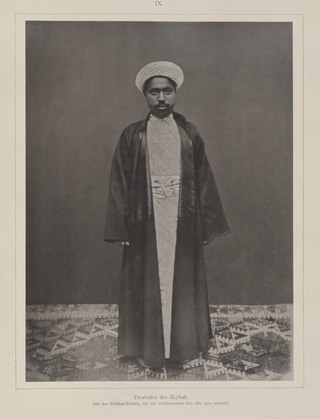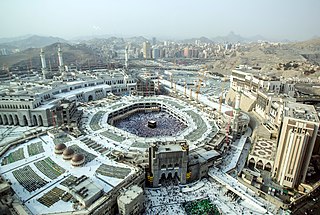You can help expand this article with text translated from the corresponding article in Arabic. (June 2024)Click [show] for important translation instructions.
|
Saleh Zain Al-Abidin Al-Shaibi (died 21 June 2024) was a Saudi caretaker (Kaaba). [1]
You can help expand this article with text translated from the corresponding article in Arabic. (June 2024)Click [show] for important translation instructions.
|
Saleh Zain Al-Abidin Al-Shaibi (died 21 June 2024) was a Saudi caretaker (Kaaba). [1]

The qibla is the direction towards the Kaaba in the Sacred Mosque in Mecca, which is used by Muslims in various religious contexts, particularly the direction of prayer for the salah. In Islam, the Kaaba is believed to be a sacred site built by prophets Abraham and Ishmael, and that its use as the qibla was ordained by God in several verses of the Quran revealed to Muhammad in the second Hijri year. Prior to this revelation, Muhammad and his followers in Medina faced Jerusalem for prayers. Most mosques contain a mihrab that indicates the direction of the qibla.

The Black Stone is a rock set into the eastern corner of the Kaaba, the ancient building in the center of the Grand Mosque in Mecca, Saudi Arabia. It is revered by Muslims as an Islamic relic which, according to Muslim tradition, dates back to the time of Adam and Eve.
Al-Nābighah, al-Nābighah al-Dhubiyānī, or Nābighah al-Dhubyānī; real name Ziyad ibn Muawiyah ; was one of the last Arabian poets of pre-Islamic Arabia. "Al-Nabigha" means genius or intelligent in Arabic.

Kiswa is the cloth that covers the Kaaba in Mecca, Saudi Arabia. It is draped annually, though the date of draping has changed over the years. A procession traditionally accompanies the kiswa to Mecca, a tradition dating back to the 12th century. The term kiswa has multiple translations, with common ones being 'robe' or 'garment'. Due to the iconic designs and the quality of materials used in creating the kiswa, it is considered one of the most sacred objects in Islamic art, ritual, and worship.
Fatima bint Asad was the wife of Abu Talib and the mother of their son Ali ibn Abi Talib.
Shayba ibn Hāshim, better known as ʿAbd al-Muṭṭalib, was the fourth chief of the Quraysh tribal confederation and grandfather of the Islamic prophet Muhammad.

Upper Yafa or Upper Yafa'i, officially the State of Upper Yafa, was a military alliance in the British Aden Protectorate and the Protectorate of South Arabia. It was ruled by the Harharah dynasty and its capital was Mahjaba, a small town on a hill located about 50 km northeast of Habilayn. Upper Yafa was one part of Yafa'a, the other part being Lower Yafa.
Mohammed Saleh Al-Khilaiwi was a Saudi football defender from Saudi Arabia. At the club level, he played mostly for Al-Ittihad in his home country.

Al-Hazem SC is a Saudi professional football club based in Ar Rass that competes in the Saudi First Division League the second tier of Saudi football. It was founded in 1957.

The Masjid al-Qiblatayn, also spelt Masjid al-Qiblatain, is a mosque in Medina believed by Muslims to be the place where the final Islamic prophet, Muhammad, received the command to change the Qibla from Jerusalem to Mecca. The mosque was built by Sawad ibn Ghanam ibn Ka'ab during the year 2 AH and is one of the few mosques in the world to have contained two mihrabs in different directions.

The Bani Shaiba are an Arab clan belonging to the Banu Abd al-Dar sub-clan, that are part of the larger erstwhile Quraysh tribal in Hejaz, in Saudi Arabia. They comprise mainly of the descendants of Uthman ibn Talha, his father Talha ibn Abdullah and his grandfather Abd al-Dar ibn Qusai and are known to have historically held the keys to the Kaaba since pre-Islamic 1500 BC and subsequently in the aftermath of the Conquest of Mecca by the Islamic prophet Muhammad in 630.
Al Hijr may refer to:

The Kaaba, sometimes referred to as al-Ka'ba al-Musharrafa, is a stone building at the center of Islam's most important mosque and holiest site, the Masjid al-Haram in Mecca, Saudi Arabia. It is considered by Muslims to be the Bayt Allah and is the qibla for Muslims around the world. The current structure was built after the original building was damaged by fire during the siege of Mecca by Umayyads in 683 AD.

Amrullah Saleh is an Afghan politician who served as the first vice president of Afghanistan from February 2020 to August 2021, and acting interior minister from 2018 to 2019. He was the head of the National Directorate of Security (NDS) from 2004 to 2010.

The Yemeni revolution followed the initial stages of the Tunisian Revolution and occurred simultaneously with the 2011 Egyptian revolution and other Arab Spring protests in the Middle East and North Africa. In its early phase, protests in Yemen were initially against unemployment, economic conditions and corruption, as well as against the government's proposals to modify Yemen's constitution. The protesters' demands then escalated to calls for the resignation of Yemeni President Ali Abdullah Saleh. Mass defections from the military, as well as from Saleh's government, effectively rendered much of the country outside of the government's control, and protesters vowed to defy its authority.

The Maqām Ibrāhīm is a small square stone associated with Ibrahim (Abraham), Ismail (Ishmael) and their building of the Kaaba in what is now the Great Mosque of Mecca in the Hejazi region of Saudi Arabia. According to Islamic tradition, the imprint on the stone came from Abraham's feet.

Masjid al-Haram, also known as the Sacred Mosque or the Great Mosque of Mecca, is considered to be the most significant mosque in Islam. It encloses the vicinity of the Kaaba in Mecca, in the Mecca Province of Saudi Arabia. It is among the pilgrimage sites associated with the Hajj, which every Muslim must perform at least once in their lives if able. It is also the main site for the performance of ʿUmrah, the lesser pilgrimage that can be undertaken any time of the year. The rites of both pilgrimages include circumambulating the Kaaba within the mosque. The Great Mosque includes other important significant sites, such as the Black Stone, the Zamzam Well, Maqam Ibrahim, and the hills of Safa and Marwa.

Aguila Saleh Issa Gueider is a Libyan jurist and politician who is the Speaker of the Libyan House of Representatives since 5 August 2014. He is also a representative of the town of Al Qubbah, in the east of the country.

A sitara or sitarah is an ornamental curtain used in the sacred sites of Islam. A sitara forms part of the kiswah, the cloth covering of the Kaaba in Mecca. Another sitara adorns the Prophet's Tomb in the Al-Masjid an-Nabawi mosque in Medina. These textiles bear embroidered inscriptions of verses from the Quran and other significant texts. Sitaras have been created annually since the 16th century as part of a set of textiles sent to Mecca. The tradition is that the textiles are provided by the ruler responsible for the holy sites. In different eras, this has meant the Mamluk Sultans, the Sultans of the Ottoman Empire, and presently the rulers of Saudi Arabia. The construction of the sitaras is both an act of religious devotion and a demonstration of the wealth of the rulers who commission them.

Muhammad Sadiq Bey was an Ottoman Egyptian army engineer and surveyor who served as treasurer of the Hajj pilgrim caravan. As a photographer and author, he documented the holy sites of Islam at Mecca and Medina, taking the first ever photographs in what is now Saudi Arabia.